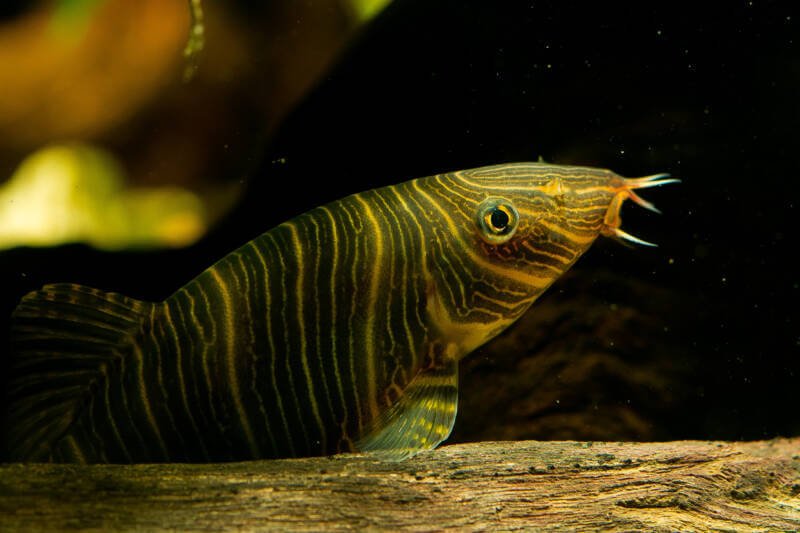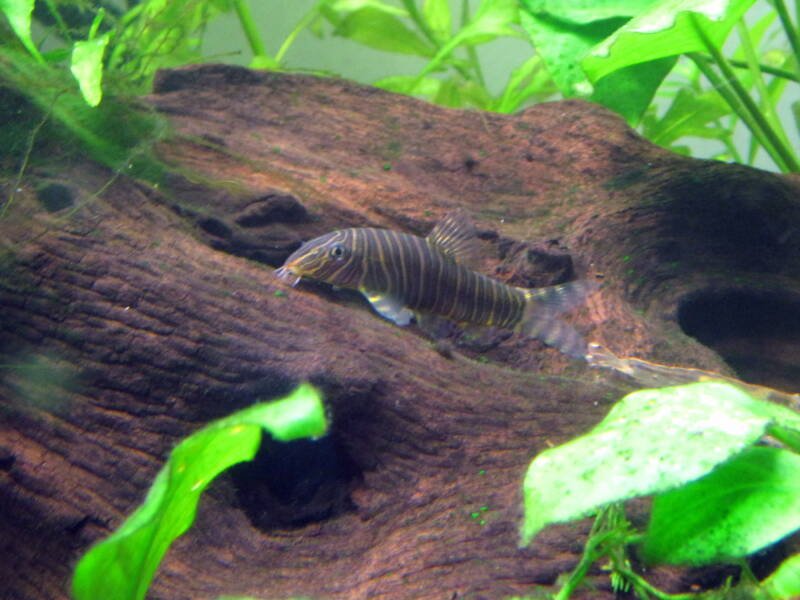With its lovely coloration, it is easy to see why the zebra loach (Botia striata) is an aquarium favorite.

This freshwater fish is a member of the Cobitidae family and hails from slow-moving waters in southern India.
It is a peaceful species, spending most of its time along the bottom.
They do require a bit more care on the part of the aquarium keeper to ensure their water conditions are stable, and they eat a varied diet.
Overall, they are a great addition to a community tank that can be around for many years.
At a Glance
| Tank Size: | 30 gallons |
| Group Size: | At least five |
| Water Temperature: | 73 – 79°F (23 to 26°C) |
| pH: | 6.5 to 7.5 |
| Hardness: | 5 to 12 dGH |
| Lifespan: | 5 to 8 years (10 to 15 with good care) |
| Breeding: | Not recommended in a home setting |
| Adult Size: | 3 to 4 inches (8 to 10 cm) |
| Usual Place in the Tank: | Bottom |
In this article
Natural Habitat
The Zebra loach has an extremely limited habitat in nature. It lives in streams flowing through the Western Ghats mountain range.
The streams in this region have slow or moderate currents, clear water, and rocky or sandy bottoms. Trees overhang and shade these waters, and leaf litter is prevalent.
Due to over-development, deforestation, and pollution, the Zebra loach’s population has been reduced.
It is now on the International Union for Conservation of Nature’s list of endangered species.
Appearance and Biology

The Zebra loach has beautifully-patterned coloration. Their yellow-green body has nine vertical, thick blue-green bands. These bands are striped with white lines, giving the zebra appearance.
The stripes angle slightly forward in front of the eyes, then switch to a backward angle on the rest of the body.
The loach’s dorsal and tail fins are translucent and feature brown or black bands that continue the body’s pattern.
Their heads taper downward toward the mouth, which has four pairs of barbels.
Their body shape grows larger toward the dorsal fin, then tapers off again at the tail. The dorsal fin resembles half of a fan, and the tail fin is forked.
There is not much deviation between male and female zebra loaches. However, the female can appear rounder in the belly when carrying eggs.
Size
Expect your zebra loach to grow to between three and four inches in length (7 to 10 cm).
Lifespan
A wonderful thing about Zebra loaches is that they have a long lifespan.
Although most fall in the range of 5 to 8 years, they can live anywhere from 10 to 15 years with good care.
Behavior
In nature, Zebra loaches tend to be nocturnal, but in an aquarium, they can be quite active during the day.
They tend to stay in the bottom area of the tank and love to explore the features there.
They are a shoaling fish. Keeping them in pairs or very small groups can stress them and lead to aggression, so consider a group of at least five in your community aquarium.
Occasionally, Zebra loaches can nip at each other but rarely bother other species. They do love to eat snails, so be aware if you intend to add those to your tank.
How many per gallon?
Because Zebra loaches are happiest in a group of at least five, plan on a minimum tank size of 30-gallons.
Naturally, an even larger tank would be better to allow more room for plants and other species.
Tank Setup

The best tank setup for Zebra loaches is one that has planted areas, open space for swimming, and places to hide.
Cover your tank with a tight-fitting lid, as loaches can occasionally leap out of the tank.
All-in-all, you want to try to replicate their natural habitat as much as possible.
Decorations

Line the bottom with smooth gravel or fine sand. This will help to protect your loach’s delicate barbels and underside.
Place plenty of rocks, caves, or driftwood to allow places to shelter or hide.
Plan on a planted tank, as this species loves highly-oxygenated water. The plants can also encourage algae growth, which the loaches will eat.
Water Conditions
These fish prefer clean water. When introducing a Zebra loach to your tank, make sure the water conditions have stabilized, as fluctuations can stress your fish.
Plan on changing out 20-30% of the water each week. Vacuum the gravel, but do not remove the algae on the decorations.
Keep the temperature between 73 – 79°F (23 – 26°C).
The pH range should be between 6.5 and 7.5, and the hardness between 5 to 12 dGH. Test your water weekly to ensure a stable, consistent environment.
Equipment
The Zebra loach receives filtered light in its natural habitat due to overhanging foliage. Keep the lighting in your tank dim with a low-output lamp.
You could also place floating aquarium plants for the same effect.
You want to encourage some algae growth, but you want to be able to see into your tank! Use a magnet algae cleaner to keep the glass nice.
Install a filter that will turn over the tank’s water 10 to 15 times per hour, oxygenate the water, and provide minimal current.
Try an under-gravel filter for oxygenation and waste reduction.
Tank Mates
The best tank mate for a Zebra loach is four more Zebra loaches! That said, they are a peaceful species and are great for a community tank.
Consider the following to pair with your Zebra loach:
- Other loaches (clown loach or yoyo)
- Barbs (tinfoil, cherry, or Odessa)
- Tetras (neon, ember)
- Sparkling gourami.
Avoid the following:
- Other bottom dwellers, such as corys
- Freshwater snails
- Betta fish or slow-swimming fish with long fins.
Food and Diet
Zebra loaches are omnivores. They will eat sinking catfish pellets as well as tablets and flake foods.
Supplement their diet with live and frozen foods, such as brine shrimp, bloodworms, daphnia, and mosquito larvae.
They also eat vegetables, such as algae wafers, cucumber, lettuce, or zucchini. Feed them several small feedings per day.
Breeding
Breeding Zebra loaches is not something for most hobbyists. They are quite difficult to breed outside of a commercial setup.
Commercial breeders have access to the equipment and hormones required to breed this fish species.
Hardiness
Zebra loaches are somewhat more susceptible to disease due to their minimal scales and sensitive head areas.
Some experience with similar fish is ideal as they are sensitive to medications used to treat common tank diseases.
Diseases
Ich – this disease presents as white spots and is caused by a parasite. Set up a separate tank for treating your loach and give them half of the recommended dosage of medication.
“Skinny disease” – this disease is also caused by parasites and causes your fish to lose weight. It can be treated with medication.
Infection from cuts – the Zebra loach is prone to cuts from sharp objects in the tank. Use a sandy or smooth substrate and keep your loach with other non-aggressive species.
Frequently Asked Questions
How many Zebra loaches should be kept together?
To allow for natural shoaling behavior and to reduce stress to your fish, Zebra loaches should be kept in groups of at least five.
Do Zebra loaches eat algae?
Zebra loaches will snack on algae that grow on objects in the tank.
Will Zebra loaches eat shrimp?
Brine shrimp can be a healthy part of your Zebra loach’s diet.
Do Zebra loaches eat snails?
These fish love to eat freshwater snails.
Final Recommendations
Overall, the Zebra loach is a beautiful, active, and peaceful fish. As such, they are a great addition to a community tank.
The cost per fish runs between $7.50 to $8.00. Plan on keeping a group of at least five.
The Zebra loach may not be the best fish for a beginner.
They require very clean water, are more susceptible to disease, and are difficult to breed in a home setting.
Have you kept Zebra loaches in your community tank?
What difficulties did you encounter?